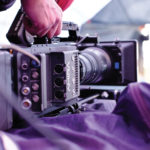
The Amazing Spider-Man’s 2.4 PetaBytes of 4k Scans
Posted on Jun 11, 2014 by Alex Fice
Electro from The Amazing Spider-Man 2 movie was just part of its amazing storage requirements.
As we dived head first in to a 4k and more future, we should get used to seeing the PetaByte word. But The Amazing Spider-Man 2’s amazing data load is just part of the technical story.
Sony Pictures Imageworks crafted over 1000 visual effects shots, Sony Pictures Post Production provided sound, in its first project in Dolby Atmos, and Colorworks performed film scanning, conforming and colour grading all in 4K.
Working under the supervision of senior visual effects supervisor Jerome Chen, Sony Pictures Imageworks created three new villains—Electro, Rhino and Goblin—and developed fully-digital CG environments representing New York’s Times Square, Manhattan skyscrapers, a next generation hydroelectric plant and an art deco-era clock tower among other one-off effects seen throughout the film.
The film’s sound team was led by sound supervisors/designers Addison Teague and Eric Norris, and re-recording mixers Paul Massey and David Giammarco. Working in the newly-renovated William Holden Theater on the Sony Pictures Entertainment lot, Massey and Giammarco mixed the soundtrack natively in Dolby Atmos and finished in Atmos, Auro and 5.1 formats, a combination that has never been done before.
At Colorworks, film dailies — amounting to more than 1.5 million feet of 35mm film — were scanned to 4K digital format prior to editorial. The film later returned to Colorworks for conforming, final colour grading (in 4K) and mastering in 2D and stereoscopic 3D.
Collaboration between the teams was by Sony Pictures Entertainment’s Production Backbone, the studio’s shared storage environment. Original production elements, along with associated metadata — cummulatively amounting to more than 2.4 Petabytes — were stored on the backbone’s shared-storage environment where it was accessible to sound and picture editors, visual effects artists and others, as needed and in appropriate file formats. The backbone also simplified delivery of elements to external visual effects vendors, who were able to access the backbone through secure, high-speed connections.
“Scanning all of the original film elements at 4K allowed us to work at the highest quality and implement a true digital workflow to the production,” explained Bill Baggelaar, Senior Vice President of Technology for Colorworks and Post Production. “That saved significant time. The backbone not only provided access to data, it also tracked progress. If an editor or a visual effects artist made a change, it was quickly available to all the other members of the team, increasingly important for quick turn around on a dynamic film like The Amazing Spider-Man 2”
MPC Vancouver also teamed up with Director Marc Webb and Sony Pictures Imageworks VFX Supervisor Jerome Chen to complete more than 300 shots for the movie.
The main areas of work included Max Dillon falling into a tank of mutant electric eels and beginning his transformation into Electro; Harry Osborn’s vein bulging transformation into the Green Goblin; and an explosive aircraft collision.







